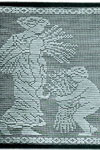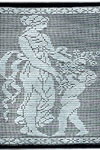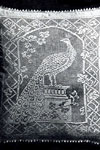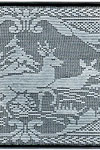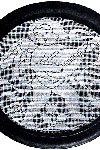Filet Crochet Patterns
Filet Crochet takes its name from Filet Brodé which it resembles. It is at its very best when done with fine thread and the finest needle, yet it is handsome in coarse thread. For the best effect, the crochet must be firmly and evenly done.
Filet Crochet Patterns
MATERIALS. — Any good thread is suitable. In the list below the size of Cordonnet crochet cotton is given with the size of hook and the number of meshes in an inch of the work. As the size of crochet varies with the worker, the number of spaces given is only approximate.
No. of Cotton |
No. of Hook |
Meshes to Inch |
No. of Cotton |
No. of Hook |
Meshes to Inch |
1 |
4 |
3 |
40 |
11 |
7 |
2 |
9 |
4 |
50 |
12 |
7½ |
3 |
9 |
4 |
60 |
12 |
8 |
5 |
9 |
4½ |
70 |
14 |
8½ |
10 |
9 |
5 |
80 |
14 |
8½ |
20 |
11 |
6 |
100 |
14 |
9 |
30 |
11 |
6½ |
150 |
14 |
10 |
EXPLANATION OF TERMS. — Chain (ch). With a slip knot on the needle, pull a loop through, then a loop through that, etc.
Slip stitch (sl). A loop on the hook, hook through work, pull loop through both.
Single crochet (s c). A loop on the hook, pull loop through work, pull loop through the two loops.
Double crochet (d). A loop on the hook, thread over hook once, pull a loop through work, loop through two loops, loop through remaining two.
Treble crochet (t). A loop on the hook, thread over hook twice, pull a loop through work, crochet off in twos.
Double treble (d t). A loop on the hook, thread over hook three times, pull a loop through work, crochet off in twos.
Space or mesh (s or sp). Chain 2, miss 2 sts of foundation, 1 d in next.
To add meshes at the beginning of a row work the required number of ch, plus 5 for turning, and proceed as usual.
The method of adding open meshes at the end of a row is as follows : Chain 2, a d t, joining where the last d was joined. Each succeeding d t is fastened under 2 threads in the middle of the preceding d t.
Puff stitch. A d in top of d below, 6 d in space below, join top of seventh d to top of second d with a sl st on wrong side of work, a d in top of next d below. Care must be taken to have all puffs on same side of work.
Picot (p). Chain 6, sl in first of chain.
EXPLANATION OF TABLES. — Tabulated directions are used for some of the designs, as they save space, and many workers find them easier to follow than the usual directions.
Each horizontal row of figures stands for one entire row of crochet. Every row is to be read from left to right. When you come to the end of a row of figures, turn your crochet. The letters at the top of each column tell what the numbers in that column represent. "S" means "spaces." "D" means "double crochet." The foundation chain is always three times the number of spaces in the first row, plus six. For example, in the pattern, Fig. 4, the first row has 35 spaces or meshes ; therefore, chain 111, turn. The first four rows read as follows:
1st row—Make 1 d in the ninth chain from hook, * ch 2, miss 2 stitches of foundation, 1 d in next. Repeat from * until 35 spaces are made. Chain 5, turn.
2d row—Same as 1st row.
3d row—Two sp, 4 d, 7 sp, 19 d, 10 sp, 4 d, 8 sp, turn.
4th row—Five sp, 4 d, 1 sp, 4 d, 1 sp, 4 d, 1 sp, 4 d, 6 sp, 7 d, 4 sp, 10 d, 2 sp, 13 d, 2 sp.
From this, it will be seen that no attention is paid to blocks (solid mesh), although you can prove up your work in this way. Each single block consists of 4 d. Two or more blocks consist of three times the number of blocks plus 1. Always make 5 chain in turning. This makes the first space. When the row begins with d, use three chain for turning.
REFERENCE LETTERS USED IN TABLES. — Special
reference letters are sometimes used in tabulated directions, and their meanings are as follows :
E.—Slip stitch over one space or four d.
W.—Chain 8, turn, 1 d in fourth ch from hook.
X.—Used to fill squares that would otherwise be left blank; the use of the letter prevents confusion.
F.—This means a "festoon" which is made as follows: Chain 3, miss 2 stitches of foundation, s c in next stitch, ch 3, miss 2 stitches of foundation, d in next stitch.
B.—Block. Chain 5, miss 5 stitches of foundation, d in next stitch; blocks are usually combined with festoons.
A neat way of finishing a triangular piece of Filet Crochet is with triangular meshes on the oblique edge. On the end of a row this may be done by joining with a t instead of 2 ch and d. For the beginning of a row, 3 chain are made for turning instead of the ordinary 5 chain.
We are aware that some workers in Filet Crochet do not depend on directions, but prefer to follow an illustration of the finished work. It will be found that a number of the designs in this book have been arranged to meet the preference of such workers.
Unless the edge is of d, it is a good plan to reinforce the edge with a row of s c, put on after the pattern is completed. Sometimes the edge of single crochet is varied by making a picot at every 10th or 12th stitch.
The ability to crochet square should be learned and cultivated, as resulting in superior work and greater range of design.
When crocheting for any length of time, the fingers may become chafed. To avoid this, a good plan is to use a finger from an old glove.
LAUNDERING. — Although a new piece of work does not usually need to be laundered, it adds greatly to its appearance. The crochet should be squeezed, not rubbed, in good soap-suds. It should then be rinsed well without twisting.
When crochet is to be combined with linen, both the linen and crochet should be thoroughly shrunk. The crochet is then pinned on the cloth and the cloth cut to fit the crochet. This is the only way to ensure a perfectly smooth piece of work.
After a piece is finished, it should be pressed on a thickly padded board, under damp cloth.
| Pattern Categories Browse the categories to help you find the patterns you're looking for. |
||

